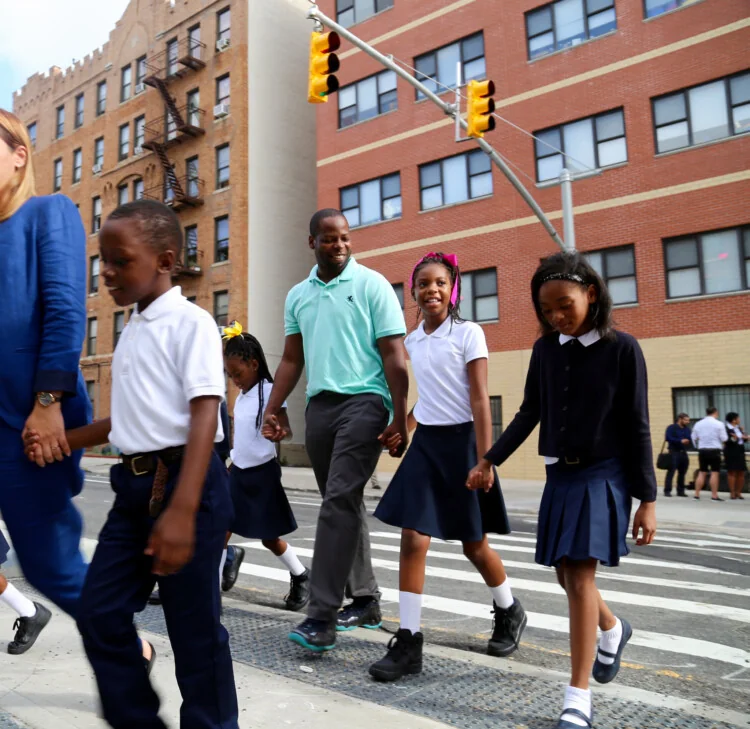Newcomer unaccompanied youth in the U.S.
The United States defines an unaccompanied minor as an immigrant who is under the age of 18 and not in the care of a parent or legal guardian at the time of entry, who is left unaccompanied after entry, and who does not have a family member or legal guardian willing or able to care for them in the arrival country. Unaccompanied minors1, or “newcomer youth,” are part of a large global migrant group that are settling in the U.S. due to high rates of violent crime, gang violence and recruitment, and severe economic insecurity in their home countries (Zak, 2020).
Upon arrival in the U.S., unaccompanied minors face strict and often inhumane policies, mistreatment, deplorable conditions, and procedures designed to keep as many of them in custody as possible. Currently, 8,500 migrant teens and children who crossed the border without their parents are being housed in Department of Health and Human Services shelters, with 87% of those in custody between the ages of 13-17 (Levinson, 2020; Miroff, 2021).
For unaccompanied immigrant youth who eventually settle in the U.S., barriers to integration persist, including inadequate support for navigating complex immigration and K-12 education systems, as well as a legal system that in which unaccompanied minors have no right to legal counsel, even when facing deportation. For the schools and districts that serve these students, a lack of federal financial assistance and a reliance on ad hoc local support systems only deepen existing obstacles.
The Educational Challenge(s)
In our study, we are exploring how school and district personnel describe and manage the challenges that newcomers face upon entering the U.S. Additionally, we are examining the challenges that schools and districts encounter when welcoming these students. These include:
- enrollment and registration processes, including complicated registration systems and language barriers,
- lack of personnel to manage the enrollment process and a lack of background knowledge about working with newcomer immigrants, and
- fear of immigration enforcement in local communities that necessitate trauma-informed approaches to serving these students.
Challenge 1: School Enrollment Systems and Processes
To enroll in a public school in the U.S., families must first provide multiple documents and navigate complicated systems. For unaccompanied newcomers, providing documentation such as proof of residence in the school district, a birth certificate, and vaccination records can be a considerable obstacle. Some districts in the U.S. have made the decision at the state level to not require documentation, with one district official explaining,
“We have a big issue with immigration taking away all of their documents, and not providing them with the proper paperwork, especially in detention. It depends on the family. But, most of the time, the unaccompanied youth [minors under age 18 who migrate without a parent] have nothing. ZERO. We end up photocopying part of any immigration-related document and we have approved that document as a government ID, and we absolutely hate to put immigration documents in our files. But in that kind of case, we don’t have a choice, you know what I mean?”
Another respondent echoed the difficulty of registering students who were detained on arrival in the U.S.:
“A lot of times, parents when kids are released from detention to a sponsor [family member or distant relative] they don’t even have anything showing that they’re the parent or relative. We have to dig through the immigration-related paperwork packets that they do have, and we kind of connect the information and we use that. When people migrate, they don’t usually carry paperwork with them yet we ask for it.”
This practice of “connecting the dots” is necessitated by the complicated nature of the immigration system and the seemingly arbitrary requirements for enrolling in school. Students and families, for their part, also face challenges with the initial steps of school enrollment. Across school districts, the research shows similar dynamics related to the difficulty of online registration systems. As respondents noted:
“It’s very difficult for families to access the online registration system.”
“Usually, parents [contact us] for help because they’ve tried to use our system and it’s hard. It doesn’t make sense for families.”
Challenge 2: Personnel Shortages
While all children, regardless of immigration status, have a right to a public education, personnel decisions at the district level can contribute to difficulties exercising this right. For instance, insufficient staffing means inadequate capacity to assist the high volume of students and families looking to register and enroll:
“It’s the way school systems work; everything is so hard to do. We have to request additional staff to help manage this enrollment process as we are trying to navigate it.”
Research shows that additional, preferably bilingual, educators and staff are also needed to ensure that newcomer unaccompanied youth receive the assistance they need. One school counselor said:
“It is really crazy. We were supposed to get more staff, but our central office hiring was frozen and so it’s also very complicated to try to hire our people right now. These positions are not a priority. You might have a counselor or someone in English-as-a-second language evaluation who are usually in districts to oversee the process, and sometimes summer staff. It’s not enough.”
Challenge 3: Anti-immigrant sentiment and a climate of fear and the need for trauma-informed approaches
While our respondents—social workers, counselors, and staff who primarily interact with immigrant students—were more aware of the needs of immigrant students and families than indicated in prior research, there is still a strong need to educate district and school personnel about migration experiences and to engage in trauma-informed, asset-based perspectives of immigrants.
For example, one respondent recalled serious anti-immigration opposition from members of the community and the county—specifically educators within her school—when she advocated for a structured support system in a separate school to best meet the needs of immigrant students.
Another participant commented:
“Students and families have struggled asking for and receiving community-based services through the school due to fears about immigration issues and how to engage in the community. Students are worried about their families and how to manage day to day at times with regards to the immigration enforcement changes.”
The reality is that newcomers face unimaginable conditions and experiences before, during, and after migration, which remain part of their everyday lives. One participant commented:
“The needs of immigrant students need to be addressed in the area of trauma. Many are recalling and having difficulty with witnessing death/murder, being apart from parents …. It impacts their ability to learn, and districts need to know this.”
Nearly all of the participants in this project discussed newcomers’ trauma, which is often ongoing because of the anti-immigrant climate in schools and communities and the constant threat of deportation and surveillance. To summarize, one participant in schools said,
“They live with the trauma of having had family members deported since their arrival or from separation during migration. They also live in constant fear of being deported. They walk the halls hearing some ignorant staff members [in their schools] calling them ‘illegals or aliens’ or similar references.”
Conclusion: Policy recommendations for districts
Any policy to improve outcomes for unaccompanied newcomer minors must address the considerable obstacles these youth encounter before and after migrating to the U.S.
Findings across a national sample of school personnel and a deeper case study of district personnel in one state consistently point to three areas as requiring critical attention: 1) improving registration and enrollment processes, including providing multilingual support; 2) hiring culturally aware and responsive personnel with for both classroom and support roles; and 3) improving the climate toward immigrants within spheres of control.
Working toward these priorities might involve strategies such as developing asset-based programs and systems to support immigrant families and providing professional development and knowledge-sharing opportunities for all school personnel to improve awareness about the needs of immigrant students and their families. Meanwhile, critical school personnel— not just one social worker or counselor—ought to receive trainings on immigration policy, enforcement practices, and the trauma experienced by many immigrant students and their families. In addition, staff must collaborate to advocate rather than engage in ad hoc or individual efforts. With a better understanding and appreciation for the experiences unaccompanied minors have overcome and the obstacles that remain, educators and school administrators can do more to develop trust, establish avenues of communication, improve access to community resources, and strengthen trust with immigrant families.
Notes
References:
Greenberg, M. et al. (2021). Strengthening Services for Unaccompanied Children in U.S. Communities. Migration Policy Institute, Retrieved 2021: https://www.migrationpolicy.org/sites/default/files/publications/mpi-unaccompanied-children-services_final.pdf
Levinson, A. (2020, August 27). Unaccompanied immigrant children: A growing phenomenon with few easy solutions. migrationpolicy.org. https://www.migrationpolicy.org/article/unaccompanied-immigrant-children-growing-phenomenon-few-easy-solutions
Miroff, N. (2021, March 10). At border, record number of migrant youths wait in adult detention cells for longer than legally allowed. The Washington Post. https://www.washingtonpost.com/national/unaccompanied-minors-detention-cells/2021/03/10/a0d39390-81c6-11eb-bb5a-ad9a91faa4ef_story.html
Zak, D. (2020, November 2). Fact sheet: Unaccompanied migrant children (UACs). National Immigration Forum. https://immigrationforum.org/article/fact-sheet-unaccompanied-migrant-children-uacs/





